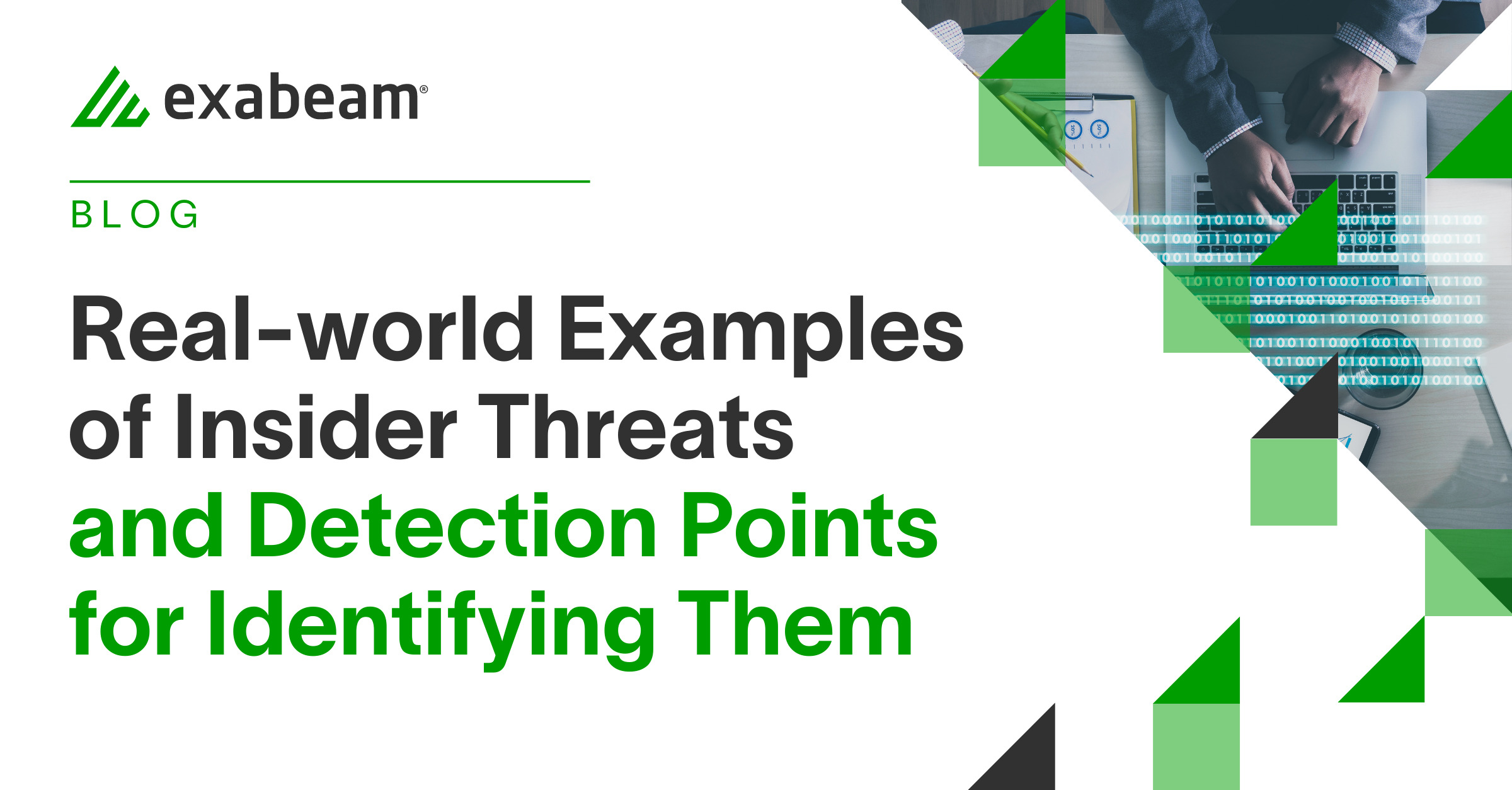Insider threats are an ever-present danger to organizations, manifesting in nightmares such as data breaches and intellectual property theft. Detection of these threats can be particularly challenging. In our last post, we discussed the various types of insider threats, their consequences, and best practices for safeguarding against them. In this second post of our series, we’ll tell you about real-world examples of insider threats and discuss the detection points that can be utilized to identify them. By understanding the common activities associated with insider threats and leveraging data feeds and data science for their evaluation, organizations can significantly enhance their security posture.
In this article:
- The role of modern SIEM solutions in detecting insider threats
- 9 real-world examples of insider threats
- 9 detection points for identifying insider threat activities
- Applying data science to insider threat evaluation
- Conclusion
The role of modern SIEM solutions in detecting insider threats
Advanced security information and event management (SIEM) solutions play a crucial role in detecting and mitigating insider threats. These solutions have evolved beyond simple log management and correlation, incorporating advanced features to detect anomalies in user behavior, prioritize alerts, and automate incident response.
Here are four ways modern SIEM systems detect insider threats:
- User and entity behavior analytics (UEBA) — UEBA capabilities within SIEM solutions use machine learning (ML) algorithms to establish baselines of normal user behavior and detect deviations from these baselines. This helps identify potentially malicious activities, such as unauthorized access, unusual data transfers, or other signs of insider threats.
- Advanced correlation and prioritization — Modern SIEM solutions can correlate events across multiple data sources, enabling security teams to detect complex attack patterns that might otherwise go unnoticed. Additionally, these solutions can prioritize alerts based on factors such as the severity of the threat, the sensitivity of the affected assets, and the potential impact on the organization.
- Automated incident response — By integrating with other security tools, security intelligence, and IT systems, advanced SIEM solutions can automate various aspects of the incident response process, such as gathering evidence, performing threat analysis, and executing remediation actions. This helps security teams respond more quickly to insider threats and reduces the potential damage.
- Centralized visibility and reporting — Advanced SIEM solutions provide a central platform for monitoring and analyzing security events across the organization, offering a comprehensive view of the threat plane. This visibility helps security teams identify trends, spot potential weaknesses in their defenses, and make informed decisions about resource allocation and risk mitigation.
9 real-world examples of insider threats
- Sales manager stealing customer information — A sales manager with access to the organization’s customer database exports sensitive data, such as contact information, purchasing history, and preferences. They may use this information for personal gain or sell it to competitors, potentially damaging the organization’s reputation and customer relationships.
- Engineer copying product plans for competing startup — An engineer working on a critical project secretly copies proprietary designs, blueprints, or source code to share with a rival company or use in their own startup. This can lead to the loss of competitive advantage and potential legal issues related to intellectual property theft.
- IT manager illegally trading on insider information — An IT manager with access to confidential financial data or upcoming business announcements uses this information to make trades on the stock market, profiting from non-public information. Such actions can lead to regulatory investigations, legal penalties, and reputational damage.
- Scientist selling confidential documents to a foreign country — A scientist working on cutting-edge research sells sensitive documents, such as research findings or experimental data, to a foreign government or organization. This can undermine national security, compromise the organization’s competitive advantage, and result in legal ramifications.
- Intelligence agency contractor leaking data to the press — A contractor working for an intelligence agency leaks classified information to the press, potentially compromising ongoing operations, national security, and the agency’s credibility.
- Data analyst’s stolen hard drive with personal information —A data analyst’s personal laptop or hard drive, containing sensitive employee or customer data, is stolen or misplaced. This can lead to data breaches, identity theft, and regulatory penalties for failing to protect sensitive information.
- Employee falling victim to spear phishing attack — An employee is tricked into revealing their login credentials or other sensitive information through a targeted phishing attack. This can give cybercriminals access to the organization’s network, allowing them to steal data or launch further attacks from within.
- Customer support employee selling credentials to hacker group — A customer support employee, motivated by financial gain or a grudge against the organization, sells their login credentials or access to sensitive systems to a hacker group. This can result in data breaches, financial loss, and damage to the organization’s reputation.
- Engineering intern leaving default password vulnerable to supply chain attack — An intern working on a development project accidentally leaves a default password in place, making a critical system vulnerable to unauthorized access. This can lead to supply chain attacks, where cybercriminals infiltrate the organization through trusted partners or suppliers.
9 detection points for identifying insider threat activities
- Endpoints — Monitor user activity on laptops, desktops, and mobile devices to identify suspicious behavior, such as unauthorized access or data exfiltration.
- File servers —Track file access, creation, modification, and deletion on file servers to detect attempts to steal or tamper with sensitive data.
- Identity management systems — Monitor user account creation, modification, and deletion, as well as password changes and failed login attempts, to identify potential insider threats.
- Database servers — Keep track of database access, queries, and transactions to detect unauthorized access or attempts to exfiltrate sensitive information.
- Badge readers — Monitor physical access to restricted areas using badge readers, looking for unauthorized entry or unusual access patterns.
- Printers — Track printing activity, especially of sensitive documents, to detect potential data exfiltration attempts.
- Development systems — Monitor code repositories, build systems, and testing environments for unauthorized access, code changes or unexpected duplication/deletion, or data leaks.
- Cloud-based activities — Monitor user activity within cloud-based applications and services to identify potential insider threats or data breaches.
- USB thumb drive access — Track the use of removable storage devices, such as USB thumb drives, to detect data exfiltration attempts or the introduction of malware.
Applying data science to insider threat evaluation
By analyzing vast amounts of data and utilizing advanced analytics capabilities, organizations can gain valuable insights into user behavior, identify suspicious activities, and detect potential threats. Here are some key data science methodologies that can be applied to the evaluation of insider threats:
- Behavioral baselining and anomaly detection — Use ML algorithms to establish a baseline of normal credential and device behavior based on historical data, and flag deviations from the baseline as potential indicators of insider threats. This can help identify previously unknown attack patterns or suspicious activities that deviate from established norms.
- Peer group analysis — Compare the activities of individual users with those of their peers or organizational unit (OU), identifying outliers or unusual behavior that may signal malicious intent or negligence.
- Privileged account analysis — Analyze the activities of users with privileged access, such as system administrators or executives, to detect potential abuse of power or unauthorized access to sensitive resources.
- Shared account analysis — Monitor the usage of shared accounts, which can be a weak point in security and provide an opportunity for insiders to hide their activities. Look for unusual patterns of access, such as multiple concurrent logins or attempts to access sensitive resources outside of normal working hours.
Conclusion
By understanding the common activities associated with insider threats and using various data feeds and data science techniques for evaluation, organizations can significantly improve their ability to detect and respond to insider threats. Implementing a modern SIEM solution with robust features, such as behavioral baselining, peer group analysis, and privileged account analysis, can provide invaluable insights into the activities within an organization, enabling effective insider threat detection, investigation and response (TDIR).
Stay tuned for the third post in this series, where we’ll cover various insider threat indicators and explain how an advanced SIEM solution can detect them.
To learn more, read The Ultimate Guide to Insider Threats
Do you know what the biggest threat is to your organization? The answer may surprise you. It’s your own employees, contractors, and other insiders. These trusted insiders have authorized access to sensitive information and can cause significant harm to your organization, whether they mean to or not.
Insider threats are a growing concern for organizations worldwide, and it’s essential to understand the risks they pose and how to defend against them. That’s why we’ve created this comprehensive guide to help you better understand what insider threats are and how to protect your organization from them.
Read this eBook to learn about:
- What insider threats are and why they’re a growing concern
- The importance of simulation and security training for defending against insider threats
- A modern approach to insider threat detection, including real-world examples and case studies
- Advanced best practices for insider threat programs, including data science, data feed detection points, and use cases.
With this guide, you’ll know how to improve your organization’s overall security posture with faster, easier, and more accurate insider threat detection, investigation, and response. Download now!

Similar Posts
Recent Posts
Stay Informed
Subscribe today and we'll send our latest blog posts right to your inbox, so you can stay ahead of the cybercriminals and defend your organization.
See a world-class SIEM solution in action
Most reported breaches involved lost or stolen credentials. How can you keep pace?
Exabeam delivers SOC teams industry-leading analytics, patented anomaly detection, and Smart Timelines to help teams pinpoint the actions that lead to exploits.
Whether you need a SIEM replacement, a legacy SIEM modernization with XDR, Exabeam offers advanced, modular, and cloud-delivered TDIR.
Get a demo today!













